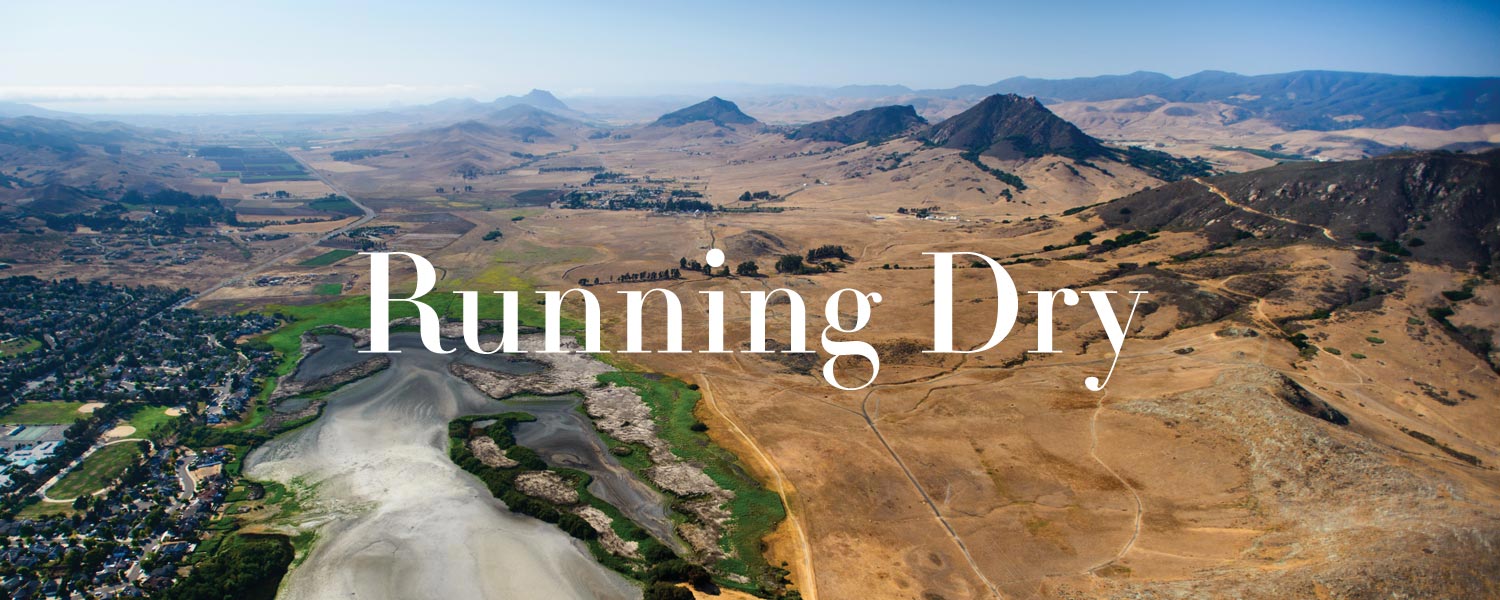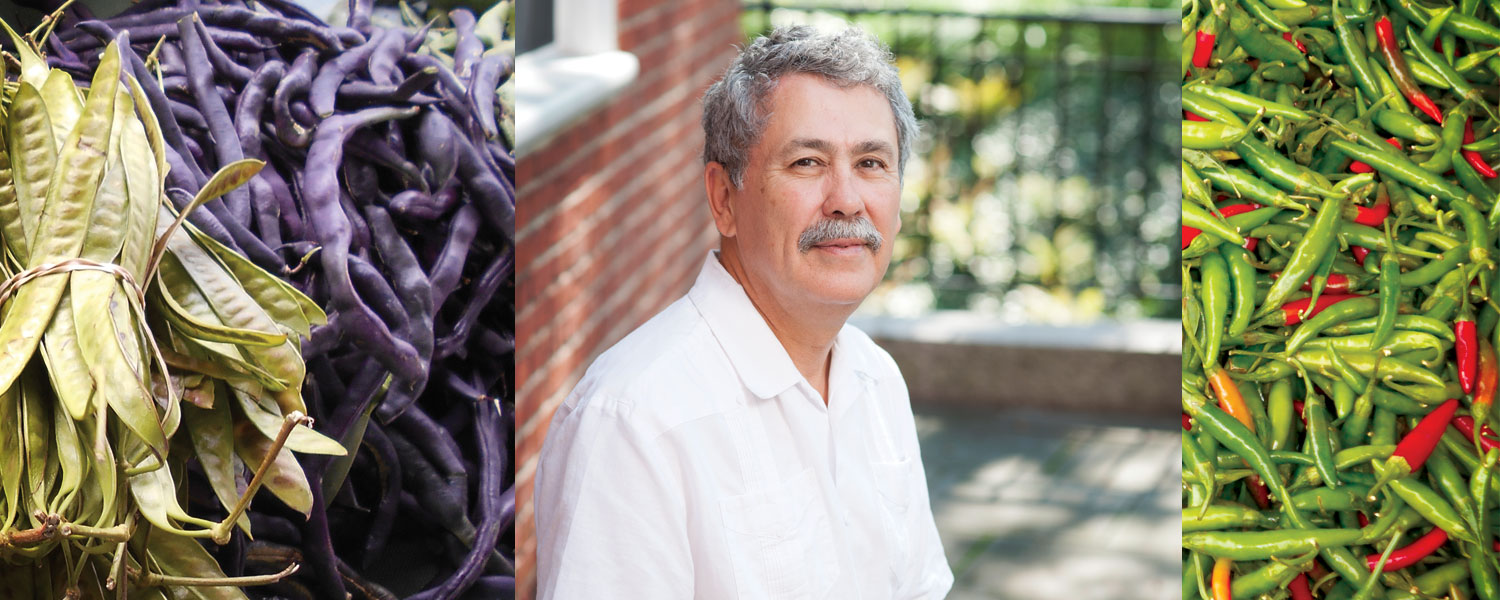By Larry Peña
As one of the state’s most important agriculture schools, Cal Poly can’t help but feel the sting of the ongoing California drought. This fall, Cal Poly will host a conference of the United Nations University, the academic and research arm of the U.N. At this conference, international researchers will discuss slow-moving disasters, including drought, in a setting that gives them an up-close look at a perfect test case. It’s just one of the many ways Cal Poly is addressing a crisis that impacts every aspect of life in California.
For Cal Poly Professor Charles Burt, the view from Interstate 5 is a perfect metaphor for the California drought. “People see a lot of trees and farmland, so they think there’s no problem,” he says as he drives north on the freeway that serves as California’s main artery. “But five miles away, it’s a different story.”
Burt, one of the state’s leading experts in irrigation research and the founding chair of the nationwide Irrigation Association Certification Board, is on his way to the state capitol in Sacramento for a summit of some of the state’s best minds in a variety of fields. The hope is that at this meeting, new ideas will emerge to fight the effects of the ongoing drought, now in its fourth year.
It’s hard to overstate the effects of the crisis. According to Chris Surfleet, a professor in Cal Poly’s Natural Resources Management & Environmental Sciences (NRES) Department who studies water conservation and watershed management, even if rains return to normal levels, that might not be enough.
“It takes four to five inches of rain before the soil gets wet enough to start moving the water around and starting river flow,” he says. “Once that happens, at average rainfall, it could take several years for us to get back to normal.”
“There’s not a whole lot that can be done when a drought hits — people just run out of water,” says Burt. “There are no magical solutions. We’re using more water than we have. It’s that simple.”
But while there may be little to do about the amount of water available in the state, there’s much that can be done to use water more
efficiently — and some of the best work in that area is coming from Cal Poly’s Irrigation Training & Research Center (ITRC), a group housed within the College of Agriculture, Food & Environmental Sciences (CAFES). The group operates like a business within the BioResource & Agricultural Engineering Department, working with industry to develop irrigation technology and techniques while using those applied research contracts as educational opportunities for the next generation of innovative leaders in the irrigation field.

The water level has dropped drastically at Lake San Antonio, a reservoir in northern San Luis Obispo County.
“We constantly come up with new things,” says Burt, who founded the ITRC and serves as its board chair. “We’ve developed technology for monitoring water balances and made advances in satellite imaging to understand water use. We have students in the San Joaquin Valley showing farmers how to be more efficient. We’re the only game in town when it comes to automation of large-scale agriculture systems in the state. We work in Bulgaria, Uzbekistan, Kazakhstan and Mexico.
“But we’re not gizmo people — we’re strategy people,” he adds. “It’s all about thinking in terms of whole systems. Everything is connected.”
Burt is concerned that fewer and fewer people are being trained to carry on those techniques in the future. “Long term, there aren’t enough irrigation specialists around. Irrigation programs across the West have all disappeared, he says. “We’ve maintained a strong program here, largely because of our practical, hands-on approach. We focus on educating California students and addressing California issues and, as a result, our students are doing real work and getting real jobs after graduation.”
For its part, Cal Poly has been working proactively to be as efficient as possible with its own water resources. Part of that is a response to Gov. Jerry Brown’s recent mandate for state schools to reduce water consumption by 25 percent compared to 2013 levels, but Cal Poly’s efforts in this area are much older than that directive. “We didn’t wait for a record drought to start conserving water,” says Dennis Elliot, director of Energy, Utilities and Sustainability at Cal Poly. “Since 2000, conservation efforts have allowed us to keep campus water usage flat, in spite of a 60 percent increase in building square footage and a 100 percent increase in on-campus housing.”
Over the past few months, vast lawns across campus have been “going gold” — intentionally culled and allowed to wither away. There’s a push to update plumbing fixtures and remove inefficient elements of the campus water system. And everywhere students congregate, from dorms to classroom buildings to the Recreation Center, signs remind them to use water carefully and sparingly. In July, Cal Poly won the Water Efficiency/Site Water Quality sustainability award at the California Higher Education Sustainability Conference in San Francisco.
The university’s vast agricultural land holdings are currently exempt from the governor’s mandate, but that hasn’t stopped CAFES’ department of Agricultural Operations from doing its part. “When I met with campus leadership as a whole, I told them we would do our best to hit the same goals as the rest of campus as a way to show our support for that effort and for the state,” says program director Kevin Piper.
According to Piper, Cal Poly’s ag lands are on track to hit that voluntary 25 percent goal this year, through technical upgrades to irrigation systems and modifications of watering practices. The voluntary cuts are providing a Learn by Doing opportunity to students. BioResource & Agricultural Engineering Department students have installed irrigation monitoring systems, run efficiency tests, and designed new pump stations. “We’re throwing them into an extreme real-world situation,” says Piper. “They are exposed to state-of-the-art equipment and techniques, so when they leave and become resourceful professionals in the industry, they have that familiarity.”
For Cal Poly social sciences Professor Ryan Alaniz, drought resilience isn’t just an agricultural issue or resource management issue — it’s an issue with deep social and cultural implications.
Where There Once Was Water
Brittany App is a Central Coast-based photographer and frequent collaborator with Cal Poly Magazine. Over the past two years, App has been pursuing a special personal project: capturing powerful images that document the dramatic changes across the American West in the face of the drought. Her goal is to raise awareness for the crisis and encourage Californians to conserve.
“Everyone wants to figure out ‘Where can we get more water?’, but we’re not talking about who might not already have water,” says Alaniz. “The poor are going to be negatively affected more than the wealthy if water prices increase. So it becomes an equity issue — just because you can afford to pay for it, does that mean that you deserve more water than others?”
Over the last year, Alaniz and his students have been focusing on how social shifts can help alleviate the problem, developing awareness campaigns to tackle water use the same way that environmental groups addressed recycling in the 1970s. “We really need to change the culture of California in terms of all our resources,” he says. “As a sociologist, I don’t think change comes from the top down as much as it comes from the bottom up — a cultural shift where Californians take responsibility for their water usage so that that becomes our cultural norm.”
Students are embracing their role in that shift. “It’s easy to say, ‘How’s this going to affect the water shortage?’ But I think that’s an easy way to get out of doing something,” says Brooke Matson, a fourth-year communication studies major who researched upgrading the university’s plumbing fixtures last spring in a course called Social Change. “This affects every single person in California, and it really takes every person who lives here to do something about it.”
The nature of a drought, compared to other types of disasters, makes it a difficult problem to address. “We see an earthquake and 300,000 people dead, and we think, ‘We have to do something,’” says Alaniz. “But with slow-onset disasters, they get used to the change for a time, until people can’t adjust any more.”
In the last year, however, California may have hit that critical mass. The silver lining of the drought is that the worse the crisis becomes, the more the state’s thought leaders turn their attention to a serious problem that began long before the rain stopped falling.
“Droughts are going to happen,” says NRES Professor Surfleet.
“I hope that the long-term effect of the drought would be a better understanding of how to use the water and better policies on allocating water. It’s not something that will happen quickly, but the fact that the issue is being raised is a positive outcome from this drought.”
At the United Nations University conference at Cal Poly in October, researchers from around the world will discuss the broad range of reactions to the drought. It’s an opportunity for international academics in agriculture, environmental resource management, public policy, and human rights to explore ways to address slow-moving crises of all types. It’s also an opportunity for thought leaders in those areas to bring their expertise to bear in this crisis.
There are no easy answers, but the fact that the crisis is bringing leading minds together is cause for hope. “What happens in California has a ripple effect on the U.S. and throughout the world,” says Alaniz, who is Cal Poly’s point person in coordinating the conference. “Ideally we’ll be planting seeds that will bloom in the future, so that ideas come out of this that can be translated across the world.”






